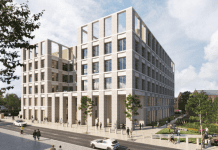Plans for Foster + Partners’ proposed Tulip tower in the City of London are set to be scrapped after the government has dismissed the planning applications
The Department for Levelling Up, Housing and Communities (DLUHC) has accepted the recommendation of planning inspector David Nicholson, who determined Tulip tower should be rejected.
In 2019 the City of London’s planning and transportation committee granted resolution planning permission for the construction of The Tulip. However, Mayor Sadiq Khan’s office rejected plans to build the 300-metre skyscraper.
The decision had been ‘called in’ by the DLUHC but Michael Gove has now refused planning permission due to the vicinity of heritage assets.
‘Visually intrusive and highly incongruous’
Commenting on the news, Duncan Wilson, chief executive at Historic England, said: “Today, the plans to build the ‘Tulip’ tower in the City of London have been dismissed by the Secretary of State for Levelling Up, Housing and Communities.
“We have always opposed the proposal, mainly due to the impact it would have on the Tower of London, and so are pleased with this decision.
“We have long been of the opinion that the ‘Tulip’ would be visually intrusive and highly incongruous from key viewpoints of the Tower, detracting from the experience of visiting the site for millions of tourists and Londoners.
“It is also our view that it would harm the extraordinary significance of the Tower of London as a World Heritage Site, and therefore the proposals ran contrary to local and national planning policies.
“We welcome this outcome, which will help to protect one of the world’s great historic monuments that has provided a stage for our shared history for over 900 years.”
‘A sign of more difficult times to come for tall buildings’
Lydia O’Hagan, associate at Charles Russell Speechlys, commented: “Gove’s decision may be a sign of more difficult times to come for tall buildings.
“Steering tall buildings through the planning system is likely to become increasingly difficult with the recent adoption of the new London Plan and upcoming developer taxes.
“However, despite the challenges, tall buildings also present unique opportunities. They can deliver more floorspace with less footprint, contribute to city life through commercial and residential accommodation and associated facilities, as well as make a positive contribution to skyline, with well-known examples including the Shard and the Gherkin.
“With an increased emphasis on brownfield development, there is still a key role for tall buildings of exemplary design in society.”

















